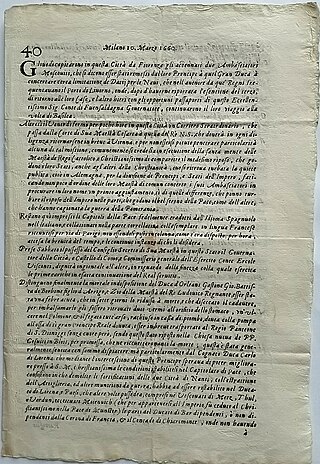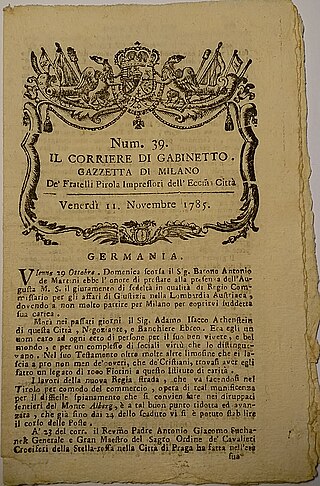 an issue of 1668 | |
| Founder(s) | Lorenzo Pellegrini |
|---|---|
| Founded | 1642 |
| Language | Italian |
| Ceased publication | June 1787 |
| City | Bologna |
Bologna was a newspaper published in Bologna from 1642 to 1787. It is considered one of the oldest newspapers in Italy.
 an issue of 1668 | |
| Founder(s) | Lorenzo Pellegrini |
|---|---|
| Founded | 1642 |
| Language | Italian |
| Ceased publication | June 1787 |
| City | Bologna |
Bologna was a newspaper published in Bologna from 1642 to 1787. It is considered one of the oldest newspapers in Italy.
Bologna was the first gazette published in the city of Bologna. The first known number still in existence is dated 28 June 1642, [lower-alpha 1] but it is probable that the printing started some months before. [1] The founder and publisher up to 1658 was Lorenzo Pellegrini, [lower-alpha 2] and the first typographer was Nicolò Tebaldini. [1] On 23 October 1643 Pellegrini obtained by the Senate of Bologna the formal privilege of publishing, but this authorization was questioned by the Papal legate (governor). On the 24 March 1646 the Bologna obtained the final formal privilege to be published. [1]
Tebaldini died on 14 March 1646 and it was followed as typographer by Giovanni Battista Ferroni. In January 1660 the printer and publisher became Giacomo Monti. [lower-alpha 3] He was succeeded by his sons Antonio Maria and Pier Maria. After the death of Antonio Maria on 16 April 1689 the newspaper Bologna changed the name of the publisher printed in the last page from Giacomo Monti to Pier Maria Monti. [2]
In this time the newspaper Bologna was issued weekly usually on Saturday. It was of four pages in a double format compared to a book (about A4 paper size), it contained news from Italy and abroad.
On 14 December 1708 the publisher became Giovanni Antonio Saffi. Since the first number of 1709, the format of the page changed from a column to two columns.
On 2 January 1788 the Saffi discontinued the Bologna and in its place published a new newspaper, the Gazzetta di Bologna, [3] reducing the size of the page and using eight pages. From July 1788 it became biweekly, published on Wednesdays and Saturdays. The Gazzetta di Bologna lasted till June 1797 when, under the Cisalpine Republic, the Saffi discontinued it for publishing another newspaper, the Monitore Bolognese, more aligned with the French. [4]

In the seventeenth century Europe the postal network touched all the main countries. The correspondence to Bologna therefore came via the postal service. Probably, most of the news was provided by publishers of foreign capital newspapers. There was also a second network that included all the major newspapers: each of them provided the news they had on their own to the gazettes of the other countries. In this way you could make newspapers of good quality and with news already verified. In addition to these privileged sources, Bologna had its own network of local correspondents, who contributed to the newspaper on a voluntary basis. Like the other newspapers, it maintained an exclusive relationship with its correspondents.
The news were grouped by places of origin. The first information was local, followed by news from Rome. Then came news from other Italian states: Kingdom of Naples, Grand Duchy of Tuscany, Duchy of Milan, Republic of Genoa, Duchy of Savoy (always in the same order). The news from abroad came from: Madrid, Lisbon, Paris (occasionally from other French cities), Lucerne (and other Swiss cities, such as Bern and Geneva), Cologne (also Frankfurt, Argentorati and Hamburg), The Hague, Brussels, London, Vienna and Poland. Finally, news was published from Venice or from Mantua.
For each news, two information were given in a row: city of origin and date. The date was important because the news was published on different dates. The reader was used to reading news about events that happened at different times: one day before for Bologna, three days before for Venice, five or seven days before for Milan, up to ten days before for Rome. The news coming from abroad brought a date that was from a minimum of ten days (France and Switzerland) to a maximum of fifty days (Lisbon) before the day the newspaper came out.

Guido Reni was an Italian painter of the Baroque period, although his works showed a classical manner, similar to Simon Vouet, Nicolas Poussin, and Philippe de Champaigne. He painted primarily religious works, but also mythological and allegorical subjects. Active in Rome, Naples, and his native Bologna, he became the dominant figure in the Bolognese School that emerged under the influence of the Carracci.

GiacomoBarozzida Vignola, often simply called Vignola, was one of the great Italian architects of 16th century Mannerism. His two great masterpieces are the Villa Farnese at Caprarola and the Jesuits' Church of the Gesù in Rome. The three architects who spread the Italian Renaissance style throughout Western Europe are Vignola, Serlio and Palladio. He is often considered the most important architect in Rome in the Mannerist era.

Lorenzo Sabbatini or Sabatini, Sabattini or Sabadini, sometimes referred to as Lorenzino da Bologna, was an Italian painter of the Mannerist period from Bologna.

The Bolognese School of painting, also known as the School of Bologna, flourished between the 16th and 17th centuries in Bologna, which rivalled Florence and Rome as the center of painting in Italy. Its most important representatives include the Carracci family, including Ludovico Carracci and his two cousins, the brothers Agostino and Annibale Carracci. Later, it included other Baroque painters: Domenichino and Lanfranco, active mostly in Rome, eventually Guercino and Guido Reni, and Accademia degli Incamminati in Bologna, which was run by Lodovico Carracci. Certain artistic conventions, which over time became traditionalist, had been developed in Rome during the first decades of the 16th century. As time passed, some artists sought new approaches to their work that no longer reflected only the Roman manner. The Carracci studio sought innovation or invention, seeking new ways to break away from traditional modes of painting while continuing to look for inspiration from their literary contemporaries; the studio formulated a style that was distinguished from the recognized manners of art in their time. This style was seen as both systematic and imitative, borrowing particular motifs from the past Roman schools of art and innovating a modernistic approach.

Cesare Nebbia (c.1536–c.1614) was an Italian painter from Orvieto who painted in a Mannerist style.
Le Vite de’ Pittori, Scultori et Architetti. Dal Pontificato di Gregorio XII del 1572 in fino a’ tempi di Papa Urbano VIII nel 1642 is an art history book by Giovanni Baglione, first published in 1642. It represents an encyclopedic compendium of biographies of the artists active in Rome during late Mannerism and early Baroque. Baglione was a Late Mannerist and Early Baroque painter and art historian, best remembered for his writings and his acrimonious involvement with the artist Caravaggio, by whom he was nonetheless greatly influenced.
Matija Ferkić or Matija Frkić was a Croatian Franciscan Conventual scholastic philosopher from Krk.
Angelo Berardi was an Italian music theorist and composer.

Stefano Orlandi was an Italian painter, active mainly in Bologna in the architectural perspective painting. He is known for painting fanciful architectural canvases, known as Capricci.

Matteo Mainardi was an Italian economist and arithmetician.

Ovidio Montalbani, also known by his pseudonym Giovanni Antonio Bumaldi, was an Italian polymath. He was a professor of logic, mathematics, astronomy, and medicine at the University of Bologna.

Il Nuovo Postiglione was a newspaper published in Venice from 1741 to 1816. With the exception of some short-lived and thematic gazettes, the Nuovo Postiglione remained the only newspaper covering foreign affairs printed in Venice from 1741 to 1778.

Milano was a newspaper published in Milan from 1640 to 1768. It is considered one of the oldest newspapers in Italy.

Il Corriere di Gabinetto - Gazzetta di Milano was a newspaper published in Milan from 1 July 1785 to 1797 by the Pirola brothers. It was known as Il Corriere di Gabinetto from 2 July 1794 to May 1796 and as Gazzetta di Milano from 21 May 1796 to his last number dated 28 December 1797.

Il Messaggiere, from 1800 Il Messaggere, was a newspaper published in Modena between 1749 and 1859, with some interruptions during the Napoleonic era. It was the official newspaper of the Duchy of Modena and Reggio.

Genova was a newspaper published in Genoa from 1639 to 1646. The issue dated 29 July 1639 is the oldest issue still in existence of a newspaper printed in Italy.

Genova was a newspaper published in Genoa from 1642 to 1684. This newspaper had sometime additional titles: in a few issues the addition was Il Sincero, other issues had the additional title Il Botticelli, while two issues had only as title the year in Latin digits.

Francesca Paci is an Italian journalist.
Agostino Lampugnani was an Italian Benedictine monk and Baroque writer.